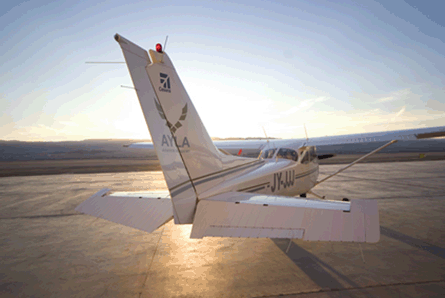From the port of Aqaba, Jordan's only access to the sea, you can see three other countries. Egypt, Israel and Saudi Arabia all virtually meet each other at the tip of the Red Sea. So it is perhaps symbolic that, in this crossroads city, would-be airline pilots from across the region are taking their first forays into the skies. Ayla Aviation Academy, set up in Aqaba two years ago, is an example of how flight training has become one of Jordan's thriving aviation sectors, attracting an international clientele way beyond the nation's own requirements.
When chief executive Marwan Atalla was seeking a location for his venture, he found other benefits in Aqaba - a modest but growing resort that straddles the Israeli border, with Egypt and Saudi Arabia a few kilometres in either direction. Its small commercial airport was underused, there was plenty of available student accommodation in town, and year-round clear skies made it ideal for visual flight training. With most of Jordan's aviation sector in the capital, Amman, the community welcomed him with open arms.
 |
|---|
© Alya Aviation Academy |
"It's a quiet town in a beautiful setting, but it's not Las Vegas, so there's no danger of the students being distracted from what they are here to do," says Atalla, an entrepreneur who caught the flying bug a few years ago, moved back to Jordan from the USA and decided to start a flying school offering European Joint Aviation Authorities-approved qualifications. His Amman-based family property company - Near East Group - is an investor in US light aircraft manufacturers Cirrus Design and Liberty Aerospace, although Ayla itself operates Cessna 172s, with students advancing to Diamond DA40s and DA42s for multi-engine training.
Just before setting up Ayla, Atalla bought UK training school Atlantic Flight Training in Coventry and used the expertise of its managers to set up the Jordanian business, the only one in the Middle East with JAA ground school approval. Students also spend the final third of their course at Atlantic, as required by the JAA. In the long term, Atalla hopes to build a network of up to five colleges across the world, with the USA, Europe and Asia likely locations.
Ayla runs four courses a year, each with 15 to 20 students, and so far has graduated about 75 pilots. Each completes 220h of flying and 860h of ground school. The vast majority are either cadets sponsored by Royal Jordanian and other Middle Eastern airlines or funded by their governments, including those of Bahrain and Kuwait. Ayla does not specifically target European students. The cost of relocating to Jordan mean it is "not a huge value proposition", admits Atalla.
 |
|---|
© Alya Aviation Academy |
Although Atalla expects student numbers to level off at 75-100 a year, the company's expansion has stuttered because of the recession, with student numbers down 30% from 2008. However, the economy has "given us some breathing room after growing so quickly", says Atalla. "Before, I was so busy with Ayla I didn't have time to travel to the UK and look at how we can develop synergies, but now I am able to go every two months."
In the past three months, Atalla has seen enquiries pick up. He says airlines are aware of the danger of seeing passenger demand soar again and be faced with a shortage of pilots. He sees the multi-crew pilot licence (MPL) - which puts the focus on preparing trainees for an immediate position in the right-hand seat - as being "no question the way of the future" and Ayla plans to offer courses soon. Another development might be a move into simulator-based type-conversion training at some stage - a potentially lucrative market, but dominated by a number of big players and with high entry costs. "We review it every quarter," says Atalla. "I don't think we will ever say no outright, but there is a chance that some day we might say yes."
Source: Flight International



















